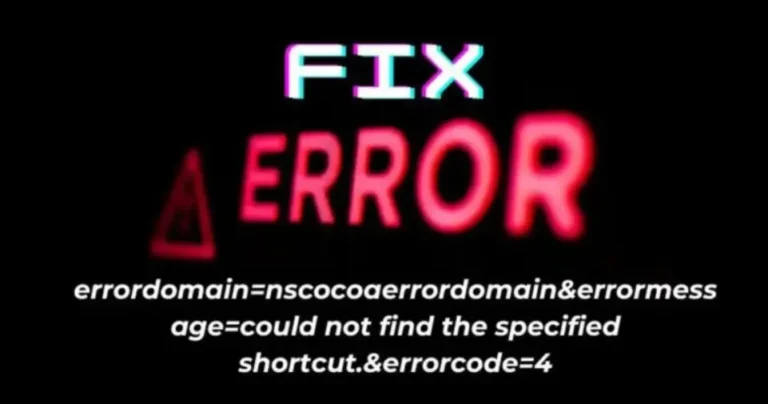If you’re an Apple user, encountering error messages isn’t uncommon. One particularly frustrating error is, “Could not find the specified shortcut” with error code 4.
This message is tied to NSCocoaErrorDomain, a domain responsible for handling errors in Apple’s Cocoa framework.
Understanding what this error means and how to troubleshoot it is key to getting your shortcuts back on track.
In this guide, we’ll walk you through the error, explain why it happens, and offer practical steps to resolve it.
This article is written to help you solve the issue in simple, easy-to-understand terms, so you can quickly resume using your Apple device without frustration.
What Is NSCocoaErrorDomain?
To troubleshoot the error, you need to know what NSCocoaErrorDomain is and why it matters.
Apple’s Cocoa framework manages high-level functions such as file operations and data handling. This domain is part of the framework responsible for catching and reporting various types of errors.
When the system can’t find a specific shortcut, it throws an error under this domain, indicating that something is preventing the shortcut from functioning properly.
Understanding this helps you pinpoint the cause of the issue, so you can take the appropriate steps to resolve it.
Why Does the “Shortcut Not Found” Error Occur?

The message “Could not find the specified shortcut” accompanied by error code 4 means that the system is unable to locate the shortcut.
This error can be caused by several factors, ranging from software compatibility issues to improper installations.
Let’s take a closer look at the most common causes so you can better understand how to fix it.
Common Causes of Error Code 4
There are a few key reasons you might be seeing the NSCocoaErrorDomain error code 4. Identifying which one applies to your situation will make resolving the issue much easier.
Shortcut Compatibility Issues
One of the most common reasons for this error is that the shortcut you’re trying to access is incompatible with your current version of macOS or iOS.
This can happen when you update your software but haven’t updated the shortcuts or apps that rely on certain system functions.
Example: Let’s say you recently upgraded your macOS, but the shortcut you frequently use was built for an earlier version. In this case, the system might not be able to recognize or execute the shortcut, resulting in error code 4.
Improper Shortcut Installation
Sometimes, the error occurs because the shortcut was not installed correctly. A broken or incomplete installation can lead the system to not recognize the shortcut. This could happen if the shortcut file was moved or deleted after installation.
Outdated Software
If your software is outdated, this could cause a wide range of errors, including error code 4.
Apple frequently updates its operating systems and apps to ensure compatibility and fix bugs. Running outdated software may lead to shortcuts failing to function as expected.
Conflicts in System Preferences
Another possibility is that system preference settings are conflicting with the shortcut. Sometimes, a specific setting in System Preferences may block or interfere with certain shortcuts, leading to this error.
Shortcut Corruption
In some cases, the shortcut file itself may be corrupted. This could happen if there was an issue during the shortcut’s creation or if it has been modified improperly over time.
If the shortcut is corrupt, the system will be unable to locate it, resulting in the error message.
How to Troubleshoot Error Code 4?
Now that you understand why this error happens, let’s dive into practical steps to fix it. By following these troubleshooting methods, you can eliminate the issue and get your shortcuts working again.
Step 1: Check Shortcut Compatibility
First, verify whether the shortcut you’re trying to access is compatible with your device’s software version.
To do this, check the shortcut’s documentation or the developer’s website. Make sure that your operating system meets the necessary requirements.
Example: If you’re using macOS Ventura, ensure that the shortcut was designed to work with that version of macOS. If not, consider finding an updated version of the shortcut or creating a new one.
Step 2: Reinstall the Shortcut
If the shortcut wasn’t installed properly, try reinstalling it. Uninstall the shortcut, then follow the original installation steps carefully.
Pay close attention to any system prompts and ensure that all components are correctly installed.
Tip: If the shortcut came from an external source, make sure it’s a trusted one. Corrupted or incomplete files can trigger the error code.
Step 3: Update Your Software
If you’re running outdated software, update your system and apps to their latest versions. Go to System Preferences > Software Update and check if there are any updates available for your macOS or iOS device. Also, ensure that the relevant apps supporting the shortcut are up to date.
Example: A friend of mine once experienced this issue because they hadn’t updated their macOS in months. After updating, the shortcut started working without any issues.
Step 4: Reset System Preferences
Sometimes, your system preferences might interfere with certain shortcuts. Resetting the affected preferences can help resolve conflicts. To do this:
- Open System Preferences.
- Navigate to the specific preference causing the issue (for example, Security & Privacy).
- Click Reset or manually adjust the settings to default.
- Restart your device.
Tip: Resetting preferences doesn’t remove your data but it restores default settings, which can resolve hidden conflicts.
Step 5: Recreate the Shortcut
If all else fails, consider recreating the shortcut from scratch. If the original shortcut is corrupted or outdated, this might be the only way to resolve the issue.
Use Apple’s Shortcuts app or a third-party application to build a fresh version of the shortcut.
When to Contact Apple Support
If you’ve followed the troubleshooting steps and still encounter the error, it’s time to seek help from Apple Support.
Apple’s support team can provide specific guidance based on your situation. They may even have advanced diagnostic tools to identify and resolve the issue quickly.
To contact Apple Support:
- Visit support.apple.com and navigate to the Shortcuts section.
- Use the chat or call options to speak directly with an Apple representative.
Preventing Future Errors

Once you’ve resolved error code 4, taking steps to prevent future issues can save you a lot of frustration.
Here are some practical tips to keep your shortcuts functioning smoothly:
Regularly Update Your Software
Make it a habit to check for updates regularly. This ensures that your shortcuts remain compatible with the latest version of macOS or iOS.
Enable automatic updates in System Preferences to avoid falling behind on important patches.
Create Backups of Important Shortcuts
If you use certain shortcuts frequently, consider backing them up. This way, if something goes wrong, you can quickly restore them without having to recreate everything from scratch.
Verify Shortcut Sources
When downloading or creating shortcuts from external sources, always ensure they come from trusted developers.
Downloading shortcuts from unknown sources increases the risk of encountering errors or malicious files.
ALSO READ
Conclusion
The error message “Could not find the specified shortcut” with error code 4 can be frustrating, but by understanding NSCocoaErrorDomain and troubleshooting effectively, you can resolve the issue quickly.
Whether it’s a compatibility issue or a problem with installation, these steps will help you get your shortcuts working again.
Remember to keep your software up to date, verify shortcut compatibility, and seek support when needed.
With these strategies, you can prevent future issues and ensure a seamless Apple experience.
FAQs
Why am I seeing error code 4 on my Apple device?
This error usually occurs when the system can’t find a specific shortcut due to compatibility issues, improper installation, or conflicts within system preferences.
How can I fix error code 4?
Check the shortcut’s compatibility, reinstall it, update your software, or reset your system preferences. If the issue persists, contact Apple Support for further assistance.
Can I prevent this error from happening again?
Yes. Regular software updates, verifying shortcut sources, and backing up important shortcuts can help prevent future occurrences of this error.

